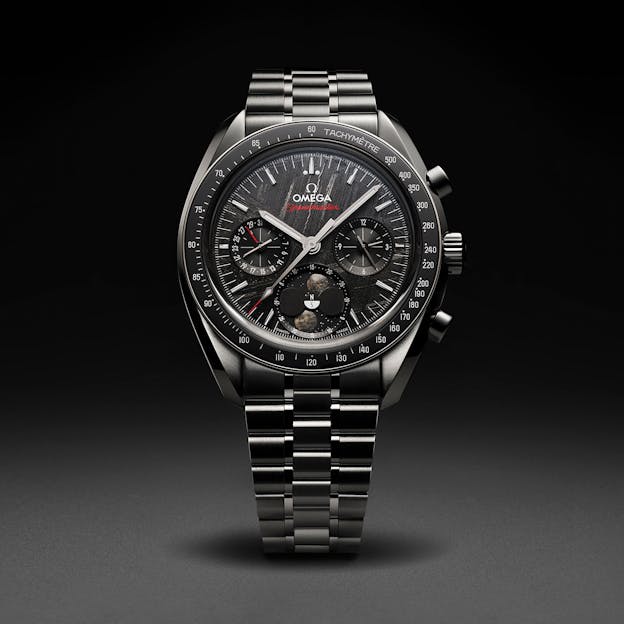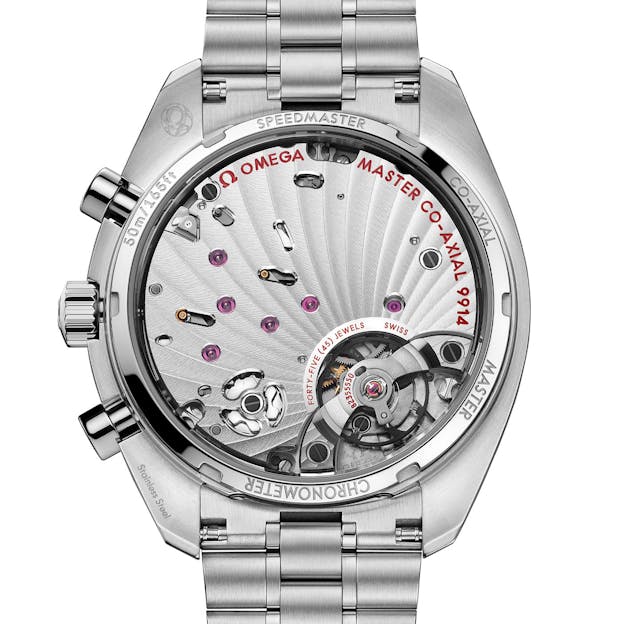Omega Launches The Speedmaster Moonphase Meteorite, With Double Hemisphere Moonphase Display
The latest version of the Speedmaster Moonphase has displays for the Northern and Southern Hemispheres, with two types of meteorite on the dial as well.
The moonphase complication is a natural addition to the Speedmaster Professional for obvious reasons; Omega first added the complication to a Speedmaster in the 1980s, in the reference 345.0809 (the “Speedy Moon”) which had a moonphase display at 12:00, and which used the caliber 866 (a moonphase variant of the caliber 861, which was the successor to the original caliber 321 used in the first Speedmasters in 1957. The original Speedy Moon was produced from 1985 through 1989; Robert-Jan Broer over at Fratello (who else) has a great breakdown of the OG model. The Speedmaster Professional Moonphase 3876.50 was produced from 2003 to 2018, and today there are a round dozen of Speedmaster Moonphase watches in the catalog, all two register chronographs with the moonphase display at 6:00.
They’re all also Master Chronometers/METAS certified, which means both chronometer certification and Master Chronometer chronometry ratings (0/+5 seconds per day maximum deviation in rate) and resistance to magnetic fields as strong as 15,000 gauss. All of these watches use the same movement – the automatic caliber 9904 or 9905; the only difference between the two is the use of Sedna Gold for the balance bridge and winding rotor in the 9905 – and they are all rather large watches, at 44.25mm x 17.1mm (the standard Moonwatch, for comparison, is 42mm x 13.2mm, with the hand-wound Master Chronometer certified caliber 3861).

This week’s launch – the Speedmaster Moonphase Meteorite – is a departure from the current template in several respects. First of all, it uses a hand wound movement, the caliber 9914, which is based on the caliber 9908/9 (no date, and date versions respectively). This is a 3/4 plate Master Chronometer certified movement, hand wound, with Omega’s version of the co-axial escapement, and with a 60 hour power reserve. There’s a center chronograph seconds hand, a subdial on the right for elapsed minutes and hours, and on the left, a pointer date display and running seconds hand (in red).

At launch, there are two versions of the watch. One has a black bezel, with a black PVD coated iron-nickel meteorite dial; the other has a blue bezel, with a meteorite dial in galvanic grey.

They’re both smaller than the existing automatic Speedmaster Moonphase models, at 43mm x 13.6mm – still not exactly small watches, but I think the reduction in size is going to be welcomed by potential clients for a Speedmaster with a moonphase display who might have found the 44.25mm x 17.1mm automatics a little too much of a good thing.

Meteorite dials in modern watches are generally made from thin sections of iron-nickel meteorites, which when cut and acid-etched, reveal a beautiful pattern of intersecting crystals; this is known as a Widmanstätten pattern, after Count Alois von Beckh Widmanstätten, who discovered them in 1808 (sticklers for giving credit where it is due also call them Thomson patterns, after the English mineralogist William Thomson, who discovered the same patterns and published his findings in 1804, four years earlier. His work was acknowledged lat thanks to the fact that he was working in Naples and became a refugee from Napoleon’s invasion, delaying wider distribution of his work. It rains on the just and the unust alike, as the saying goes).
These very large mineral crystals take millions of years to form, in the slowly cooling iron-nickel cores of planetoids in the very early Solar System which eventually broke up into smaller fragments, some of which found their way to Earth. These meteorites are billions of years old and the giant crystals require such a long cooling period that they cannot be produced artificially – a well known story, when it comes to meteorite dials, but always worth revisiting if only to remind us just how ancient these space travelers really are.
The moonphase disks are of meteoric origin as well. They’re not made from iron-nickel meteorites, however; instead they’re created from meteorites with an origin quite a bit closer to home than the Asteroid Belt. For the moonphase disks, Omega’s used lunar meteorites, which come from the lunar surface – they’re fragments of debris knocked loose by asteroid or comet impacts, which then orbit the Sun along with the Earth-Moon system until some of them are eventually drawn down our home planet’s gravity well. You can see that their mineralogical structure is different – they’re not formed of an iron nickel mixture; instead, they’re typically a heterogenous mixture of silicate minerals with other minerals thrown in (including, sometimes, iron and nickel if the lunar meteorite was knocked off the lunar surface by an iron nickel asteroid).

The combination of bezel colors and the varied textures and colors of the main dials and moonphase disks makes the two new watches very rich visually.
The other notable difference between the two Meteorite Moonphase watches, and the other Speedmaster Moonphase automatics, is the use of a double moonphase display, which shows the appearance of the Moon as seen from the Northern and Southern hemispheres. The Moon looks upside down in the Southern Hemisphere to someone used to looking at it from north of the Equator, and vice versa, but the Earth’s shadow also moves across the lunar surface in opposite directions as well depending on what hemisphere you’re standing in. In the Northern Hemisphere, the Earth’s shadow moves across the lunar surface of a waning moon from left to right; it’s the opposite if you’re viewing from the Southern Hemisphere.

Price at launch is $17,100, compared to $11,500 for the automatic Speedmaster Moonphase on a steel bracelet; the price difference is of course thanks to the meteorite dials and moonphase disks. The automatics have charms of their own – for one thing, their moonphase disks are photorealistic renderings of the lunar surface but I think there is an argument to be made for the charm of having an actual piece of the lunar surface on your wrist. Certainly it was a very long and winding road for both the dials and the moonphase disks to finally fall to Earth and end up in the watches, and while meteorite dials and moon disks aren’t unheard of or particularly rare, as with anything in fine watchmaking, it’s not just what you do but how you do it; I think these new watches do a fine job taking the implicit poetry of the original Moonwatch and its history, and making it explicit visually.
The 1916 Company is proud to be an authorized retailer for Omega. Contact us for availability.
The Omega Speedmaster Moonphase Meteorite, references 304.30.43.52.01.001 and 304.30.43.52.06.001: Case, stainless steel, 43mm x 13.6mm; water resistance 5 bar/50M, with double AR coated sapphire crystals front and back. Blue or black bezels with black PVD coated or grey galvanic coated meteorite dials, and lunar meteorite moonphase disks. Movement, Omega co-axial caliber 9914, hand-wound, METAS/Master Chronometer certified, with silicon balance spring; 60 hour power reserve from double in-series mainspring barrels; functions, time and pointer date, chronograph seconds, minutes and hours, and double hemisphere moonphase display accurate to one days’ error in 122 years. See it at Omegawatches.com.

